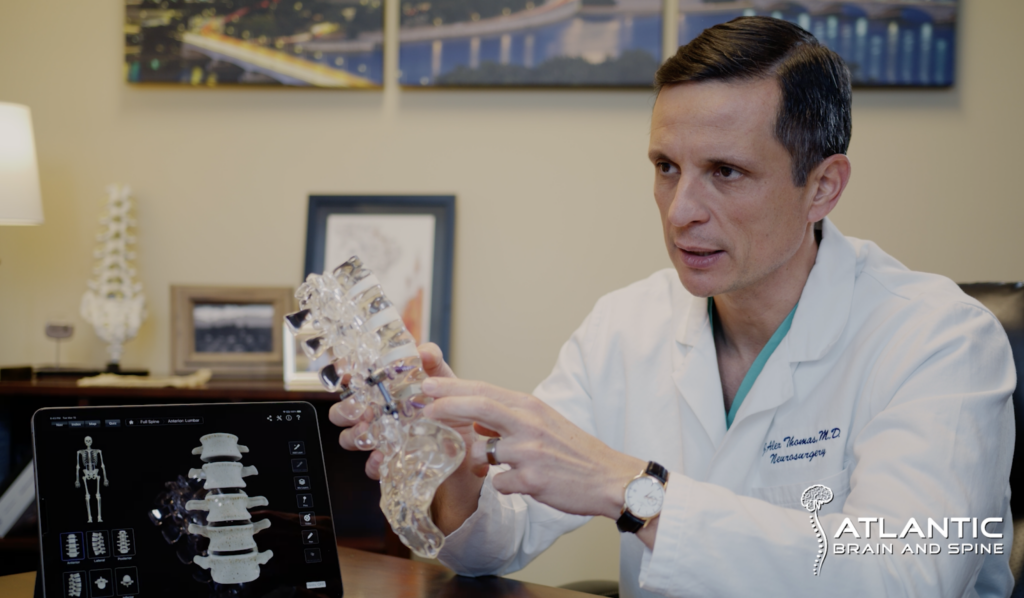
Atlantic Brain and Spine is leading the transformation of spine surgery. Our mission is to educate you, our patient, to ensure that you are comfortable and confident in your experience with us. We offer the most technologically advanced spinal surgery in the Mid-Atlantic region. If you’ve been told that you may need spine surgery, come talk to us about how our advanced surgical techniques and technology can help you.
Minimally Invasive Surgery Techniques
Lateral Single Position Surgery
If you suffer from back pain and have been told you need a spinal fusion, you may be a candidate for a new fusion technique called Lateral Single-position Surgery (LSPS).
Briefly, LSPS is an emerging concept that describes a surgical strategy that allows the placement of large spacers in the front of the spine and pedicle screw fixation at the back of the spine all in the lateral position (on your side). LSPS was pioneered by Dr. Thomas at Novant New Hanover Regional Medical Center.
Traditionally, after an Extreme Lateral Interbody Fusion (XLIF) the surgeon would close the flank incision and the patient would then be positioned prone (face down) for placement of the pedicle screws. This subjects the patient to significantly more anesthesia time and increased risks associated with repositioning. In LSPS we keep the patient on their side to place pedicle screws. This avoids wasted time “flipping” the patient which leads to dramatic improvement in OR efficiency.
LSPS is even more effective in more extensive fusion procedures. Take for example a lumbar fusion from L4-S1, a procedure commonly needed in patients with more advanced spinal degeneration.

Traditionally, a fusion from L4-S1 would involve:
- ALIF at L5/S1 in the supine position (patient on their back), close, flip.
- XLIF at L4/5 in the lateral position (patient on their side), close, flip.
- Bilateral pedicle screw fixation in the prone position (patient face down), close.
Spine surgeons call this “the rotisserie”, and it can all day.
Using LSPS, however, we perform this entire procedure with the patient in the lateral position and thus can now do these cases in 70-90 minutes. By avoiding wasted time needed to reposition patients after various stages of the fusion procedure, the patient spends much less time under anesthesia. This increased efficiency translates into less risk for the patient as well as dramatically improved outcomes. Dr. Thomas and the surgeons of Atlantic Brain and Spine are global pioneers in this revolutionary technique.
Benefits of Single Position Surgery
- Decreased time under anesthesia
- Decreased risk associated with patient repositioning
- Improved patient outcomes
- Potentially decreased costs
- Shorter hospital stays
- Shorter recovery time

NuVasive

Tech’s features and benefits
The Pulse platform is a first-of-its-kind technology designed to increase safety, efficiency, and procedural reproducibility of surgical outcomes in spine surgery.
In a single platform, Pulse integrates radiation reduction, imaging enhancement, navigation, intraoperative neuromonitoring, and spinal alignment tools. This revolutionary enabling technology helps surgeons address some of the most common clinical challenges in spine surgery, such as radiation exposure, nerve and spinal cord injury, spinal deformity, and increased case complexity.
The availability and interconnectivity of multiple spine technologies in the Pulse platform enhances a surgeon’s capabilities and enables the adoption of less invasive and more advanced surgical procedures. Adoption of less invasive surgery using Pulse may lead to:
- Reduced time anesthesia for the patient
- Decreased surgical risks
- Significant reduction of patient hospital costs
- Reduced length of stay
Dr. Thomas and the surgeons of Atlantic Brain and Spine were the first in North Carolina to use this revolutionary technology.
